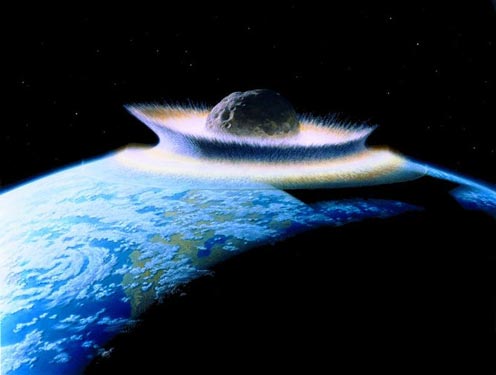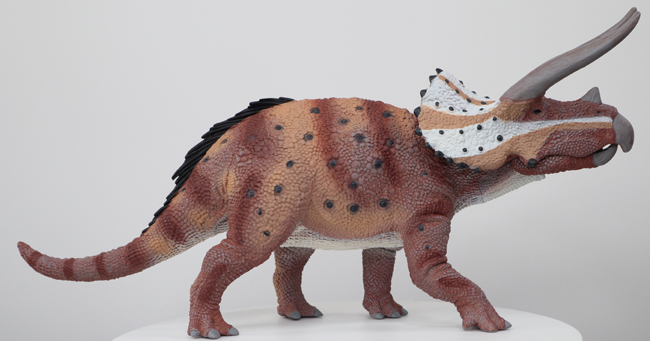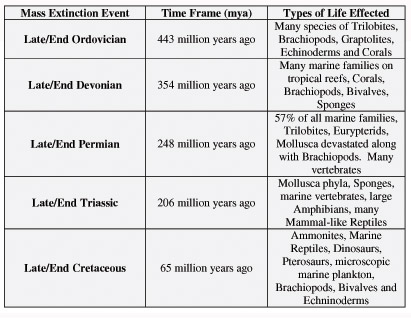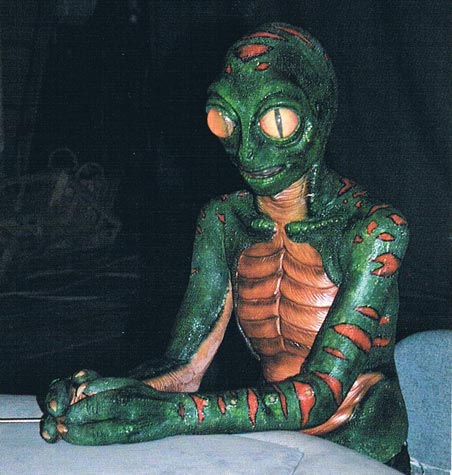Bad Luck and Bad Timing for the Dinosaurs
A new collaborative study looking at the dinosaur fossil record from the Upper Cretaceous of North America suggests that if the extraterrestrial impact event had occurred a few million years before or after it actually hit, life on Earth could be very different today. Dinosaurs could well be still roaming around. If the Dinosauria (with the exception of the birds), had not gone extinct, then it could be argued that many of the families of mammals so familiar to us today may not have evolved. The evolution of the primates, and indeed, our own species, might not ever have happened.
Unlucky Dinosaurs Sixty-six Million Years Ago?
Picture credit: Don Davis (commissioned by NASA)
Dinosaur Extinction
Similar studies into the extinction event that took place approximately 66 million years ago have been carried out before, however, this new research, published in the latest edition of the academic journal “Biological Reviews” and led by the University of Edinburgh, focused on examining an updated catalogue of North American dinosaur fossils, in a bid to understand how well the Order Dinosauria was doing in terms of species diversity at around the time of the impact event.
Previous studies, examining the number of different dinosaur species and genera preserved in Upper Cretaceous strata such as the Hell Creek Formation of the western United States, have showed that the number of different types of dinosaur fossils found declines in rocks that mark the time period towards the end of the Cretaceous. A lack of diversity in an ecosystem, or the dominance of one particular type of creature, can make such ecosystems vulnerable to sudden and dramatic changes that ultimately lead to an extinction.
An International Research Team
The research team, drawn from a number of universities and museums, conclude that prior to the impact event, our planet was experiencing dramatic environmental upheaval. Changing sea levels, fluctuating global temperatures and enormous amounts of volcanic activity were all happening. Many groups of animals and plants were under stress and the devastating impact from a six-mile-wide space rock provided the final “coup de grâce” that finished off the dinosaurs.
Soon to Become Extinct
Picture credit: Everything Dinosaur
The picture (above) shows a CollectA Deluxe Triceratops. To view the CollectA scale model series: CollectA Deluxe Prehistoric Life Scale Models.
The research team which includes scientists from Edinburgh University, Birmingham University, Imperial College (London), Oxford University, University College (London) and Baylor University (Waco, Texas) suggest that the dinosaurs’ food chain was threatened by a lack of diversity amongst large herbivorous dinosaurs. The lack of diversity, much of North America was dominated by a handful of plant-eating types of ornithischian dinosaur, created a “perfect storm” and the vulnerable Dinosauria was unable to recover from the extraterrestrial strike and its aftermath.
Everything Dinosaur team members have provided a number of teaching resources to schools that help to explain extinction events. To read an article specially prepared for use in schools at Key Stage 2 and 3 about the Cretaceous mass extinction event: Dinosaur Extinction Event – Providing Teaching Resources for Schools.
A Stimulus to Evolution
Environmental change, even dramatic global events such as an asteroid impact can in fact provide a stimulus to evolution. Earlier extra-terrestrial impacts which at first caused devastation may actually have acted as catalysts helping certain types of life to flourish.
It can be argued that once the dinosaurs became extinct, the Mammalia were able to rapidly diversify and exploit the niches left vacant by the demise of the Dinosauria, back in 2010, Everything Dinosaur reported on a scientific paper that suggested that earlier cataclysmic events and significantly benefited life on Earth.
To read this article: Extra-terrestrial Impact Led to Palaeozoic Explosion of Life.
Dr Steve Brusatte (School of GeoSciences at Edinburgh University) commented:
“Five million years earlier dinosaur ecosystems were much stronger, they were more diverse, the base of the food chain was more robust and it was harder to knock out a lot of species. If they had a few million years more to recover their diversity they would have had a better chance of surviving the asteroid impact. Dinosaurs had been around for 160 million years, they had plenty of dips and troughs in their diversity but they always recovered.”
A number of mass extinction events have been identified in the fossil record. Such mass extinctions ultimately led to a change in direction for life on Earth, permitting new types of organism to evolve.
A Table Showing the Major Extinction Events of the Phanerozoic Eon
Table credit: Everything Dinosaur
The research team hope to extend their study by taking into account vertebrate fossil data from Upper Cretaceous sediments that have been examined in China and Spain. This will help the scientists to formulate a global picture. Naturally, with such academic papers, there is always speculation as to whether or not the dinosaurs would have survived until the present day. Some speculators go further and ask the question would the dinosaurs have evolved greater intelligence, perhaps evolving into the reptilian equivalents of primates and eventually into a form of humanoid dinosaur – a dinosauroid?
Could the Earth Have Been Dominated by “Intelligent Dinosaurs”?
Picture credit: Boxtree
Dr Brusatte speculates that the Dinosauria could well have survived and that non-avian dinosaurs could make up a significant proportion of the fauna today, whilst other scientists, including a number who worked on this study remain less sure.
For example, Dr Richard Butler (Birmingham University) stated:










Hello, Dinos survived for millions of years, and then they, became extinct. Reptiles are related to these creatures.
Mary Anning, the discovery’s of Palaeontologist could show the nature of the creatures Origin of habitat, and the color of It.